BeoCord 1000
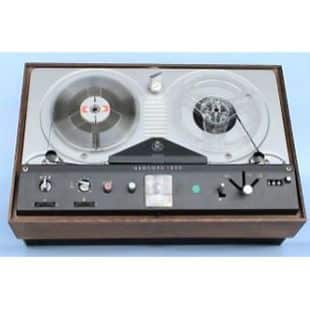

Beocord 1000 was introduced in 1966 – and the Beocord 1100 that replaced it in 1967 – were the budget models of the range. They were stereo machines but had only mono monitoring.
Beocord 1500 and Beocord 1800 eventually superceded these two models; Beocord 1800 featured a mixer as in more expensive machines and also incorporated both sound-on-sound and overdubbing capabilities. Beocord 2000 was the best-selling and the best-loved machine that the company produced; this was manufactured from 1965 to 1968 and was drowning in features many not seen on anything but professional machines until the late 1970’s.
In 1969 the company introduced Beocord 1200, Beocord 1600 and Beocord 2400.
Please let us know
Available documents are listed, if none are listed then please reach out to see if we have them.
Type | Language | Type | |
Circuit Diagram | EN | BeoCord 1000 Circuit Diagram |
Please let us know
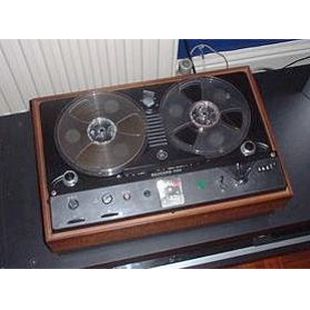
All reel sizes – including the 18cm reels. The amplifier, built on a printed integrated circuit principle, delivers no less than 10 watts of undistorted power output (built-in speaker 3 watts; extension speaker 10 watts). Automatic recording level control which may be switched on and off as desired. Two smooth-running specially engineered slack absorbers take up slack, ensuring absolutely smooth starting and stopping at all tape speeds. Electronic overload protection. Variable monitoring of the recorded signal. Top-quality low-noise tape drive motor built on rugged anti-torsion steel chassis. May be used as a separate microphone, radio, gramophone or guitar amplifier. Smooth-operating tape control lever. Large V.U. meter for visual recording level monitoring, input selector for gramophone, radio and microphone.
Separate bass and treble controls. Pause control lever with editing position. Automatic tape stop at end of tape and if tape breaks, also with metal foil. Tape counter. Speed selector with built-in on/off switch. Fast forward and reverse rewind. Output jacks for external speaker and low-impedance headphones. All jack plugs are international DIN standard types. Built-in splicing device. Permits recording from one tape recorder to another. Pilot lamp indicating that the instrument is switched on.
The Beocord 1100 is a convenient portable model (weighs 13,2kg) with built-in speaker and carrying handle, and its slim design makes it well-suited for placing on book shelves etc.
Space for radio cable, microphone with cable and stand, and recording cable.” – taken from the 1967 – 1968 Bang & Olufsen product catalogue.
Power supply: 110 – 130 – 220 – 240 volts AC
Frequency 50 Hz
Power consumption: 10 – 70 watts
Tape Transport
Number of tracks 19 – 9,5 – 4,75 cm/sec
Reel size 2 tracks record and playback
Playing times Max 18cm
Fast tape motion 150 sec. in both directions with LP tape, 540 M
Tape counter 3-digit readout (with pushbutton reset)
Wow and flutter Measured according to DIN 45,507
Tape speed variation Less than +/- 2 %
Tape stop At end of tape and if tape breaks, also where metal foil is fitted on tape, during normal forward tape motion.
Slack absorber Prevents jerks when tape is stopped and started. Tape twisting when using thin tapes (such as 3-play tapes can be avoided by bringing the tape outside the slack absorbers)
Power output 10 watts (approx. 3 watts with built-in speaker, 10 watts with external speaker)
Frequency response 19 cm/sec. : 30 – 20,000 Hz (+/- 2 dB 40 – 16,000 Hz)
9,5 cm/sec.: 30 – 16,000 Hz ( +/- 2 dB 40 – 12,000 Hz)
4,75 cm/sec.: 50 – 8,000 Hz ( +/- 2 dB 50 – 6,000 Hz)
Signal-to-noise ratio Better than 55 dB at 19 cm/sec.
Erasure 60 kHz erase oscillator combined with output stage. Ferrite erase head with twin gap.
Tone Controls Bass control range: + 14 dB – 15 dB at 40 Hz
Treble control range: +6 dB -12 dB at 10,000 Hz
Connections: Inputs Microphone 50/200 ohms – 35 µV/1000 Hz
Radio: 47 kohms – 1,6 mV / 1000 Hz
Gramophone: Low impedance : 47 kohms – 2mV / 1000 Hz
High impedance: 2,2 mohms – 75 mV / 1000 Hz
Outputs Extension speaker – 4 ohms
Radio: 4,7 kohms – 0.6 V max.
Dimensions H x W x D 20,2 x 45,5 x 29,5 cm
Weight 13,2kg
Available documents are listed, if none are listed then please reach out to see if we have them.
Type | Language | Type | Type | |
User Guide | DK | BeoCord 1100 User Guide | ||
User Guide | FR | BeoCord 1100 User Guide | ||
User Guide | DE | BeoCord 1100 User Guide | ||
Service Manual | EN | 2612 | BeoCord 1100 Service Manual | |
Service Manual | EN | 2612, 2613 | BeoCord 1100 Service Manual | |
Service Manual | EN | 4203 | BeoCord 1100 Service Manual |
Please let us know
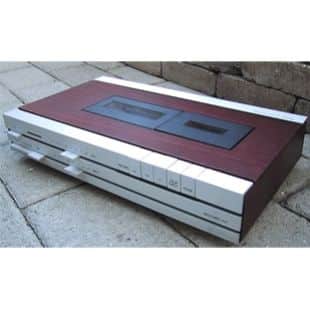
It had all the facilities you needed for recording compact cassettes and replaying them through an existing amplifier system. The combined record/playback head was made of Super Permalloy, an extremely durable material which ensured a long useful lifetime and had excellent magnetic properties. Other refinements included an electronic auto stop at end-of-tape and a switch for selecting between chromium dioxide and normal (ferric oxide) tapes.
The setting of correct recording levels was by way of individual controls used in conjunction with VU meters for left and right channels. Beocord 1101 was technically identical to Beocord 1100 but had a different exterior finish.
Compact cassette: C60-C90
Tape head: Super Permalloy
Dolby system: Yes
Iron oxide: tape Yes
Chromium dioxide tape: Yes
Stop at the end of tape: Yes
Microphone type: Mono
Wow and flutter, DIN: < +/- 0.3%
Speed deviation: < +/- 1.5%
Frequency range: 40 – 12500 Hz
Fast forward and rewind: 90 sec
Signal-to-noise ratio DIN: >54 dB
Signal-to-noise ratio chrome: >62 dB
Power consumption: 20 W
Dimensions: 40 x 8.5 x 24cm
Weight: 5.3 kg
Connections: Microphones 75 mV/10 Kohms
Available documents are listed, if none are listed then please reach out to see if we have them.
Type | Language | Type | Type | |
User Guide | DK | BeoCord 1100 User Guide | ||
User Guide | FR | BeoCord 1100 User Guide | ||
User Guide | DE | BeoCord 1100 User Guide | ||
Service Manual | EN | 2612 | BeoCord 1100 Service Manual | |
Service Manual | EN | 2612, 2613 | BeoCord 1100 Service Manual | |
Service Manual | EN | 4203 | BeoCord 1100 Service Manual |
Please let us know

It had all the facilities you needed for recording compact cassettes and replaying them through an existing amplifier system. The combined record/playback head was made of Super Permalloy, an extremely durable material which ensured a long useful lifetime and had excellent magnetic properties. Other refinements included an electronic auto stop at end-of-tape and a switch for selecting between chromium dioxide and normal (ferric oxide) tapes.
The setting of correct recording levels was by way of individual controls used in conjunction with VU meters for left and right channels. Beocord 1101 was technically identical to Beocord 1100 but had a different exterior finish.
Compact cassette: C60-C90
Tape head: Super Permalloy
Dolby system: Yes
Iron oxide: tape Yes
Chromium dioxide tape: Yes
Stop at the end of tape: Yes
Microphone type: Mono
Wow and flutter, DIN: < +/- 0.3%
Speed deviation: < +/- 1.5%
Frequency range: 40 – 12500 Hz
Fast forward and rewind: 90 sec
Signal-to-noise ratio DIN: >54 dB
Signal-to-noise ratio chrome: >62 dB
Power consumption: 20 W
Dimensions: 40 x 8.5 x 24cm
Weight: 5.3 kg
Connections: Microphones 75 mV/10 Kohms
Available documents are listed, if none are listed then please reach out to see if we have them.
Type | Language | Type | |
Service Manual | EN | BeoCord 1101 Service Manual |
Please let us know

A Red Line speaker was so flexible that it could be placed anywhere. On the ceiling, the wall, or on the floor. You could hang them semi-permanently on the wall, and if you had a party you could place them on the floor and thereby add extra emphasis to the bass. The different ways of placing them accentuated different frequencies.
You could also tilt them if you chose to hang them on the wall. This allowed you to adjust the sound image and direct the sound right at your listening position. However, Red Line was more than merely flexible. It was an impressive bass reflex speaker with a revolutionary new cabinet that ‘curved’ round the sound thereby eliminating irritating resonance because there were no parallel surfaces.
Red Line loudspeakers followed your music tastes right up the wall if you wanted! All models except the RL35 could be hung on the wall or be suspended from the ceiling; and, if your dancing feet wanted to make the most of the bass notes, then Red Line could be positioned on the floor, supported by the built-in floor stand. By using Red Line speakers, you weren’t plagued by cables that wrapped themselves around your feet like spaghetti either; Red Line’s flexible spiral cables provided the decorative and practical answer.
The shell was cast in a hard synthetic material and the shape that was devised for the range was characterised by the fact that it allowed for practically no resonance whatsoever.
You could choose Red Line in four sizes. They started with the baby 35 watt RL35 – perfect for a Beolink round-the-house system where you needed speakers all over the place. Then there was the 45.2, the 60.2 and the immensely powerful 140’s – big and beautiful with it. All the Red Line collection came in metallic grey with a distinctive red line around the edge. A matching cord was available to accentuate the red line after which the speakers were named.
In 1991 the former Redline series – RL35, 45, 45.2, 60, 60.2, 100 and 140 were superseded by the Mark 2 range of loudspeakers: RL1000, 2000, 6000 and 7000.
Dimensions W x H x D 50 x 70 x 24 cm
Weight – 15 kg
Long-term max. input power – 200 watts
Maximum noise power – 140 watts
Speaker impedance – 8 ohms
Frequency range 40 – 20,000 Hz
Power at 96 dB SPL 2 watts
Sensitivity 1 W 93 dB
Distortion – < 0.5 %
Cabinet principle – Bass Reflex
Woofer 2 x 16.5 cm – 6½”
Tweeter 13 cm – 1″
Crossover frequency – 800/3000 Hz
Net volume – 38 litres
Connections – Spring Terminals
Available documents are listed, if none are listed then please reach out to see if we have them.
Type | Language | Type | |
Service Manual | EN | Beovox RL 140 Service Manual |
Please let us know
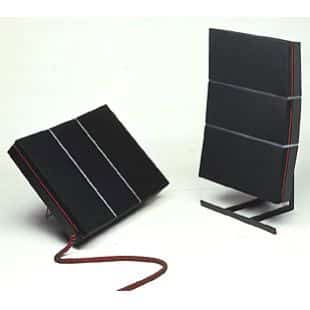
You could hang them semi-permanently on the wall, and if you had a party you could place them on the floor and thereby add extra emphasis to the bass. The different ways of placing them accentuated different frequencies. You could also tilt them if you chose to hang them on the wall. This allowed you to adjust the sound image and direct the sound right at your listening position. However, Red Line was more than merely flexible. It was an impressive bass reflex speaker with a revolutionary new cabinet that ‘curved’ round the sound thereby eliminating irritating resonance because there were no parallel surfaces.
Red Line loudspeakers followed your music tastes right up the wall if you wanted! All models except the RL35 could be hung on the wall or be suspended from the ceiling; and, if your dancing feet wanted to make the most of the bass notes, then Red Line could be positioned on the floor, supported by the built-in floor stand. By using Red Line speakers, you weren’t plagued by cables that wrapped themselves around your feet like spaghetti either; Red Line’s flexible spiral cables provided the decorative and practical answer.
The shell was cast in a hard synthetic material and the shape that was devised for the range was characterised by the fact that it allowed for practically no resonance whatsoever.
RMS power handling capacity 60 W
Music power handling capacity 90 W
Impedance 8 ohms
Frequency range +4 -8 dB 45 – 20,000 Hz
Power at 96 dB SPL 2 W
Sensitivity 1 W 93 dB
Distortion 250 – 1000 Hz < 1 %
Distortion > 1000 Hz < 0.5 %
Acoustic principle ABR, Auxiliary Bass Radiator
ABR unit: 15 x 33cm
Woofer: 2 x 16cm
Tweeter: 2.5cm
Crossover frequency: 2500 Hz
Net volume: 19 litre
Dimensions W x H x D: 54 x 40.5 x 18cm
Weight 9 kg
Available documents are listed, if none are listed then please reach out to see if we have them.
Type | Language | Type | |
Circuit Diagram | EN | Beovox RL 60 Circuit Diagram |
Please let us know
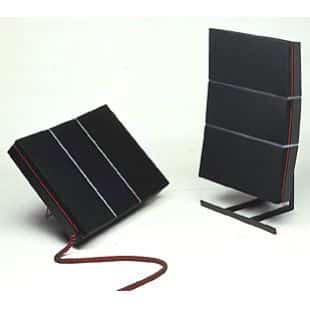
You could hang them semi-permanently on the wall, and if you had a party you could place them on the floor and thereby add extra emphasis to the bass. The different ways of placing them accentuated different frequencies. You could also tilt them if you chose to hang them on the wall. This allowed you to adjust the sound image and direct the sound right at your listening position. However, Red Line was more than merely flexible. It was an impressive bass reflex speaker with a revolutionary new cabinet that ‘curved’ round the sound thereby eliminating irritating resonance because there were no parallel surfaces.
Red Line loudspeakers followed your music tastes right up the wall if you wanted! All models except the RL35 could be hung on the wall or be suspended from the ceiling; and, if your dancing feet wanted to make the most of the bass notes, then Red Line could be positioned on the floor, supported by the built-in floor stand. By using Red Line speakers, you weren’t plagued by cables that wrapped themselves around your feet like spaghetti either; Red Line’s flexible spiral cables provided the decorative and practical answer.
The shell was cast in a hard synthetic material and the shape that was devised for the range was characterised by the fact that it allowed for practically no resonance whatsoever.
Dimensions W x H x D: 54 x 40 x 18cm
Weight 8.3 kg
Long-term max. input power 75 W
Maximum noise power 45 W
Speaker impedance 8 ohms
Frequency range 42 – 20,000 Hz
Power at 96 dB SPL 2 watts
Sensitivity 1 W 93 dB
Distortion < 0.5 %
Cabinet principle: Bass Reflex
Woofer: 2 x 13cm
Tweeter: 2.5cm
Crossover frequency 350 Hz
Net volume 19 litre
Connections: spring terminals
DIN socket
Available documents are listed, if none are listed then please reach out to see if we have them.
Type | Language | Type | |
Service Manual | EN | Beovox RL 60.2 Service Manual |
Please let us know
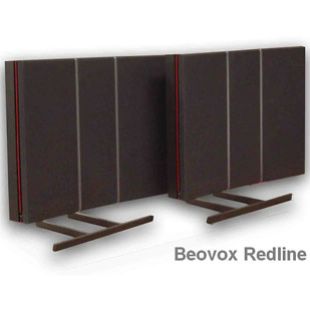
You could hang them semi-permanently on the wall, and if you had a party you could place them on the floor and thereby add extra emphasis to the bass. The different ways of placing them accentuated different frequencies. You could also tilt them if you chose to hang them on the wall. This allowed you to adjust the sound image and direct the sound right at your listening position. However, Red Line was more than merely flexible. It was an impressive bass reflex speaker with a revolutionary new cabinet that ‘curved’ round the sound thereby eliminating irritating resonance because there were no parallel surfaces.
Red Line loudspeakers followed your music tastes right up the wall if you wanted! All models except the RL35 could be hung on the wall or be suspended from the ceiling; and, if your dancing feet wanted to make the most of the bass notes, then Red Line could be positioned on the floor, supported by the built-in floor stand. By using Red Line speakers, you weren’t plagued by cables that wrapped themselves around your feet like spaghetti either; Red Line’s flexible spiral cables provided the decorative and practical answer.
The shell was cast in a hard synthetic material and the shape that was devised for the range was characterised by the fact that it allowed for practically no resonance whatsoever.
Dimensions W x H x D: 54 x 40.5 x 16cm
Weight: 6.8 kg
Long-term max. input power: 75 W
Maximum noise power: 45 W
Speaker impedance: 8 ohms
Frequency range: 48 – 20,000 Hz
Power at 96 dB SPL: 2.5 W
Sensitivity 1 W: 92 dB
Distortion: < 1 %
Cabinet principle: Bass Reflex
Woofer: 16cm
Tweeter: 1.9cm
Crossover frequency: 3500 Hz
Net volume: 16 litre
Connections: spring terminals
Available documents are listed, if none are listed then please reach out to see if we have them.
Type | Language | Type | |
Service Manual | EN | Beovox RL 45.2 Service Manual |
Please let us know
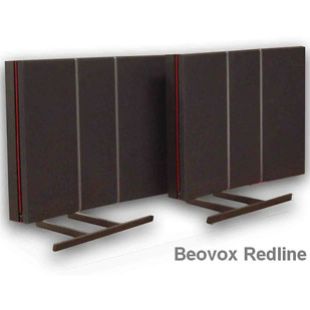
You could hang them semi-permanently on the wall, and if you had a party you could place them on the floor and thereby add extra emphasis to the bass. The different ways of placing them accentuated different frequencies. You could also tilt them if you chose to hang them on the wall. This allowed you to adjust the sound image and direct the sound right at your listening position. However, Red Line was more than merely flexible. It was an impressive bass reflex speaker with a revolutionary new cabinet that ‘curved’ round the sound thereby eliminating irritating resonance because there were no parallel surfaces.
Red Line loudspeakers followed your music tastes right up the wall if you wanted! All models except the RL35 could be hung on the wall or be suspended from the ceiling; and, if your dancing feet wanted to make the most of the bass notes, then Red Line could be positioned on the floor, supported by the built-in floor stand. By using Red Line speakers, you weren’t plagued by cables that wrapped themselves around your feet like spaghetti either; Red Line’s flexible spiral cables provided the decorative and practical answer.
The shell was cast in a hard synthetic material and the shape that was devised for the range was characterised by the fact that it allowed for practically no resonance whatsoever.
RMS power handling capacity 45 W
Music power handling capacity 60 W
Impedance 8 ohms
Frequency range +4 -8 dB 48 – 20,000 Hz
Power at 96 dB SPL 2.5 W
Sensitivity 1 W 92 dB
Distortion 250 – 1000 Hz < 1 %
Distortion > 1000 Hz < 1 %
Acoustic principle ABR, Auxiliary Bas Radiator
ABR unit 15 x 33 cm
Woofer: 16cm
Tweeter: 2.5cm
Crossover frequency: 2500 Hz
Net volume: 16 litres
Dimensions W x H x D: 54 x 40.5 x 16 cm
Weight 7.5 kg
Available documents are listed, if none are listed then please reach out to see if we have them.
Type | Language | Type | |
Service Manual | EN | Beovox RL 45 Service Manual |
Please let us know

With Bang & Olufsen earphones and the new BeoSound 2, it’s easier than ever to bring music with you. BeoSound 2 is our version of a light and pocket-friendly digital music player that allows you to enjoy hours of your favourite music when you’re on the move – without compromising on quality” B&O Catalogue 2001 – 2002
With BeoSound 2 you can download up to four 5 compact discs’ worth of music (depending on bitrate) and listen to it wherever you are, thus freeing up the hard drive of your home computer. It has a form and size that sits easily in the hand and in the pocket – and with no internal moving parts you never have to worry about knocks and vibrations ruining the musical experience.
The unit is made to be moved and built to last. Manufactured in hard-wearing stainless steel and firm rubber, it has been designed to withstand all the knocks that portability can throw its way. The keypad can be locked when on the move and with no internal moving parts, jogs and bumps will never interrupt the playing of the recorded music.
BeoSound 2 has been designed for transferring Internet-downloaded MP3s or music tracks that you have created yourself, into its solid-state memory for later playback through the supplied pair of A8 Earphones. Its built-in battery gives the user between 2 and 4 hours’ worth of uninterrupted use; the batteries should last for around 8 hours before they need recharging by placing BeoSound 2 into its specially-designed docking station. This special station provides the connection to a computer and acts as a convenient power charger for the player. Its 128 MB SmartMedia memory card (which may be expandable to 256MB) allows you to download up to 4 albums’ worth of music; the card itself may be reused as many times as you like. BeoSound 2 also plays back AAC and WMA-compatible files.
With simple and straightforward Bang & Olufsen operation, you can step easily from track to track and between different play lists. However, there is no display on the unit. Bang & Olufsen has made BeoSound 2 so simple to operate that you don’t need to look at it while in use. The intuitive layout of the keypad ensures that everything can be carried out with a thumb.
You can adjust the volume, step up or down through tracks or switch between different play lists – without ever having to take BeoSound 2 out of your pocket. And to make operation even easier, its one-touch control has been combined with a series of sounds that guide the user through each operation. In the same way, a light indicator on the docking station gives you the current status on the different functions including battery recharging.
If you upgrade the firmware on your BeoSound 2 and it locks itself ‘out’, then reset your apparatus by pressing “Vol Up” & “Vol Down” together and at the same time pressing “GO” for 2 seconds.
BeoSound 2 is created to be used together with BeoPlayer and Beolink® PC2, but will also function with Windows Media Player. However there is no point having a product that will last for years if its software is outdated in a matter of months. That’s why Bang & Olufsen has ensured that future software updates may be downloaded via the official BeoPlayer Web site. In March 2006 BeoSound 2 had an updated software version: 2.5, which allows for easier downloading to its SD card and also allows the use of a 2 GB card.
As from late 2002 BeoSound 2 may also be used by Mac users.
Music on the move from Bang & Olufsen – Portable BeoSound 2 always on hand
Bang & Olufsen takes another step into the digital music world with the introduction of BeoSound 2, a pocket-friendly digital music player. As with the successful Beolink® PC 2 concept, BeoSound 2 draws upon the computer as a source for musical entertainment and allows you to enjoy your MP3 files in a myriad of environments.
Fitting comfortably into the palm of your hand, you navigate simply between tracks or adjust the volume in your accompanying Bang & Olufsen earphones without ever needing to glance down. Utilising a minimum of buttons, BeoSound 2 provides you with both audible and tangible feedback during operation.
The smooth stainless steel cabinet and absence of sharp edges allow BeoSound 2 to slip comfortably into your pocket – and prevent it from disturbing you when you’re on the move.
“Digital music has proven itself to be an important player in today’s world of musical entertainment. BeoSound 2 harnesses the strengths of these file formats and combines them with Bang & Olufsen skills within ease of use, craftsmanship, design and sound quality. Whilst physically small, the BeoSound 2 experience is large – where integration with additional Bang & Olufsen products plays an considerable role”, says Bang & Olufsen President & CEO Torben Ballegaard Sørensen.
“BeoSound 2 is a shining example of how Bang & Olufsen puts the user situation ahead of industry hype. We aim to provide simplicity and clarity in the otherwise swirling sea surrounding Internet music, just as we do in the field of home entertainment” continues Sørensen.
BeoSound 2’s musical experiences take place in close co-operation with BeoPlayer, Bang & Olufsen’s Web music organiser, which can be downloaded free of charge to a computer from the Bang & Olufsen Web site.
BeoPlayer automatically sorts all your digital music by artist, genre, song title and album title, as well as allows you to create your own specially composed play lists. Just drag-and-drop your songs from BeoPlayer to BeoSound 2, and you are on your way out the door.
Two-way communication between BeoSound 2 and the computer allows BeoSound 2’s software to be updated simply and easily. In this fashion, BeoSound 2 endures as an up-to-date and relevant music player, benefiting from the rapid evolvement of the Internet-based music arena.
Additionally, the stainless steel cabinet takes on an appealing patina the more it is used, gaining character from sharing the pocket with keys, coins and the like. BeoSound 2’s robust construction supports Bang & Olufsen’s commitment to quality and ensures a long physical lifetime.
Six pre-recorded music samples are included on the 128 Mb SD memory card that accompanies BeoSound 2. Approximately four hours of tunes may be contained on this size card, and additional cards may be purchased separately.
Furthermore, your digital music can also be moved about in your home with Bang & Olufsen’s Beolink® PC 2, which utilises your computer as a source in a Beolink® system. BeoPlayer again takes care of all file organization, providing you with identical operation whether in the home office, kitchen or on the go.
From 14 June 2004 the product specifications of BeoSound 2 will be changed. To allow customers greater freedom in the selection of memory cards, as from 14 June 2004, BeoSound 2 will be delivered without the standard 128 MB SD card. However, three higher capacity cards may be bought from Bang & Olufsen – 128MB, 256MB and 512MB – although BeoWorld recommends that customers shop around for other more economical, equally-compatible SD cards. A8 Earphones come as standard accessories to use with BeoSound 2 XSD
Weight 90g
Cabinet finish Polished stainless steel
Flash Memory card Exchangeable MMC/SD, 128-Mbyte – gives 2-4 hours play time depending on type of coding
Music files MP3, WMA
Battery Rechargeable Lithium ion, approx. 8 hours before recharging
On/off Acoustic indication
SW Firmware updates via BeoPlayer
Docking Station: external mains adaptor SMPS – 100-240 V AC
Supported file formats: MP3, WMA
Connections:
USB for computer connection via docking station
Earphones’ mini jack
Mains adaptor: charging battery via docking station
System requirements
One free USB port
10 MB of available disc space
Windows 98,Me,2000 or XP
How much playable music?
When used with a 128MB SD card BeoSound 2 allows you to download and store up to five compact discs for later playback. The SD card may be used as many times as you wish. The built-in battery gives you around 8 – 10 hours of uninterrupted use. Re-charging the battery is simply a matter of clicking BeoSound 2 onto its docking station.
Connecting up
The specially designed docking station provides the connection to your computer and also acts as a convenient power charger for BeoSound 2.
Put it in your pocket
BeoSound 2 has a form and a size that allows it to sit as easily in your pocket as it does in your hand. The keypad can be locked when you are on the move, and with no internal moving parts, you never have to worry about knocks and vibrations interrupting the music.
Made to last
BeoSound 2 is made to be carried around and built to last. Formed in stainless steel and hard rubber, it will withstand all the knocks that may come its way. Future software updates may be downloaded from the BeoPlayer Web site.
Software compatible
BeoSound 2 is created to be used together with BeoPlayer and Beolink® PC2, but will also function with Windows Media Player.
Available documents are listed, if none are listed then please reach out to see if we have them.
Often this is because the SD card has been used in another device like a camera.
The card needs to have all hidden files deleted. The BS2 will not do this through simple formatting, so you will need to use a separate card reader.
Some tracks can be missed on a BeoSound 2 Personal Mp3 player when playing an SD card recorded on a BeoSound 4. Newer software on the BeoSound 4 should resolve this.